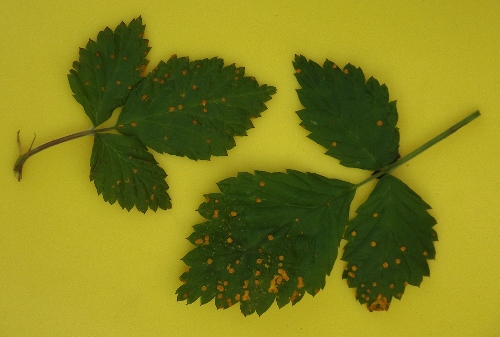Pest and Life Cycle – (Phragmidium rubi-idaei) Raspberry Rust appears as yellow pustules on the upper surface of the leaf from spring to early summer. By midsummer small orange pustules appear on the leaf underside, eventually giving way to black rust spots in autumn that overwinter. New foliage is infected by spores from leaf litter and old cane stubs, with this fungal disease being more pronounced during prolonged wet springs.
Symptoms – The symptoms vary with the season, with yellow spotting on the upper leaf surface in May and June, yellow to orange pustules on the bottom side of the leaf in midsummer, with these darkening to black by late summer to autumn. This fungal disease rarely affects yield on otherwise healthy plants, but it can also cause premature leaf drop and reduced vigor.
Management – Monitor your raspberries from spring to early summer. Prune out and discard (do not compost) any foliage showing signs of infection – however, do not entirely strip the cane of leaves.
Prevention – 1. Plant rust resistant raspberry cultivars such as ‘Boyne’, ‘Nova’ and ‘Caroline’. 2. Ensure good air circulation around raspberries by thinning the canes properly. 3. Cut out old canes to the ground as soon as cropping has finished. 4. Remove and discard fallen leaves (do not compost). 5. Replace older plantings every 5-7 years to ensure good vigor. 6. Use a delayed dormant spray of lime-sulfur at bud swell to help control this fungus or a fixed copper (at label rate) when new laterals are leafing out in spring. 7. Lightly fertilize in early spring to ensure good plant vigor. 8. Water in the morning and try to keep the foliage as dry as possible.




